- Home Page
- Kite Plans
- Box Kite Design
Box-Kite Design Examples
A Few Different Approaches
Here's a look at the various examples of box-kite design we have tried, along with an illustrative photo and video of each.
At this writing, there are two Dowel Series box designs which are a satisfying size for adult flyers. Plus a giant one which actually went overhead on 300 feet of line one hot day!
On the other hand, the two skewer designs are ideal for quite young children to fly, even in rather fresh winds. Small sail area means just a small tug on the flying line.
On this site, there's more kite-making info than you can poke a stick at. :-)
Want to know the most convenient way of using it all?
The Big MBK E-book Bundle is a collection of downloads—printable PDF files which provide step-by-step instructions for many kites large and small.
That's every kite in every MBK series.
Before getting into the imagery, you might find this summary helpful:
- 1-Skewer Box kite. (This is the quickest to make, due to its tiny size and very small amount of gluing. It flies best in moderate winds. It may require a small tail-let on one side to trim it straight and hence get the best possible flying out of it.)
- 2-Skewer Box kite. (Double the size, this kite has the minor hassle of requiring skewers to be glued together end to end, with reinforcement. However, your reward is a small box kite with a remarkably wide wind range! We've had some great flights with this design in all sorts of weather.)
- Dowel Box kite (moderate). (This is a lightly built 1.2 meter (4 foot) long box. The horizontal cross-pieces are longer than the vertical ones, giving the kite a slightly squashed appearance. This boosts performance, with just a small cost in stability. Believe it or not, I have had this box kite design end up directly overhead in moderate winds and thermals! It's not a kite for fresh winds, but it's great fun in light-to-moderate conditions.)
- Dowel Box kite (fresh). (After almost destroying the moderate-wind version in stiff breezes, I designed this one specifically for fresh winds. Although the same length, reduced sail area and reduced cross-piece lengths combine to make this kite stiffer and much more robust. And it is no slouch performance-wise either. This box-kite design will hold an impressively steep flying angle in a smooth 15 kph sea breeze. Rough inland air is no problem, but it will just go up and down a lot depending on wind strength.)
- Multi-Dowel Box kite. (This is a huge 2.4 meter (8 foot) long box. Like the dowel versions, this one is also slightly squashed for better performance. It needs a gentle-strength breeze to get it away but is comfortable in the moderate-to-fresh range. An efficient, steep flier, this big box kite pulls hard toward the top end of its wind range. It's definitely for adults only!)
Down below is a photo and a video of each MBK Box kite. They are the end results illustrated, in case you decide to use one of our books to make one of these kites.
1-Skewer Box Kite
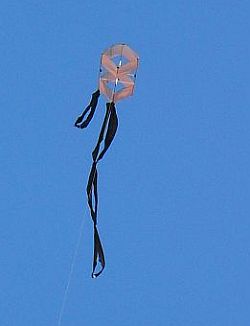 MBK 1-Skewer Box
MBK 1-Skewer BoxHere's the latest version, trimmed out and floating nicely on a warm moderate breeze at a nearby park.
It's hard to be super accurate in construction with these tiny kites. A small extra tail on one side will soon fix any problems, though, after a bit of experimentation on the flying field. But that's half the fun with tiny kites. You get a sense of achievement when the thing finally behaves itself and floats up high! At that point, you can hand the string over to your 4-year-old and watch the joy.
Here's a video, taken on the same day when this little kite broke its own altitude record:
2-Skewer Box Kite
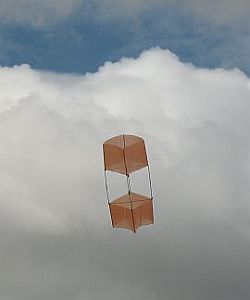 MBK 2-Skewer Box
MBK 2-Skewer BoxThis kite design is, as the name suggests, exactly twice as long as the 1-Skewer design. However, it still uses the same-diameter bamboo skewers. As a result, this kite can fly in somewhat lighter winds than the 1-Skewer Box. But it is also strong enough and stable enough to cope with very fresh winds. You can take it out in any sort of windy weather and expect to get a good afternoon's fun out of it!
We flew this kite on a 20-pound line, which gets pulled pretty straight in a stiff breeze. In lighter breezes there is some sag, but the kite will still get plenty of height on 60 meters (200 feet) of line.
See this kite in action in the video below!
Dowel Box Kite
For moderate winds
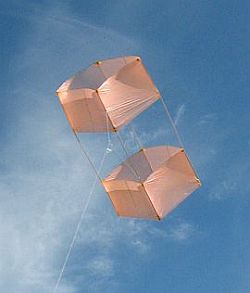 MBK Dowel Box
MBK Dowel BoxAt twice the size of the 2-Skewer Box, the Dowel Box doesn't make you feel like you are flying a "kids kite" as such. This version has had a number of great flights in conditions that you would not normally associate with box kites.
You know the old kiting saying—"box kites for strong wind." Not these days! This is particularly when a space-age material like graphite (carbon fiber) is used for spars and lightweight ripstop nylon for the sails.
But even using more traditional materials like wooden dowel for the spars, it is possible to build a box kite quite light. The inherent weight disadvantage is still there when you compare it with a diamond or a delta, for example. However, this design is proof that you can still keep a box kite up in fairly light wind if you build it right.
The wind is gusty and moderate in strength in the video down below:
Dowel Box Kite
For fresh winds
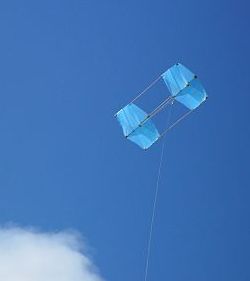 MBK Dowel Box (fresh wind)
MBK Dowel Box (fresh wind)This box design can take quite a bit of punishment from the wind. The cross-pieces are relatively short and tied together to prevent bow under pressure.
With the original bridle, this kite handled 20 kph winds comfortably. Later, I redesigned the bridle and tested the kite almost to destruction in some truly strong wind! It now handles 30 kph well, and will survive well into the 40 to 45 kph+ range.
It's all good experience, and you can always make another kite when the materials costs are so low. The pull on the line is quite firm in fresh winds. I have measured it at around 2 to 3 kg (5 to 8 lb.).
Somehow, though, I just wouldn't be game to fly this box kite design on 20-pound line! It stretches 50-pound line nice and tight, so that will do me.
The wind is gusty and fresh in strength in the video down below:
Multi-Dowel Box Kite
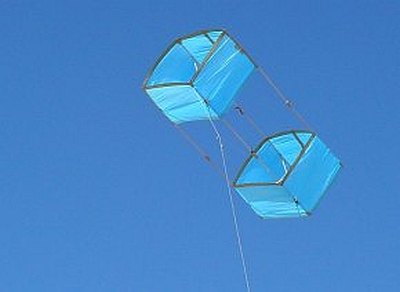 MBK Multi-Dowel Box
MBK Multi-Dowel BoxAt 2.4 meters (8 feet) long, this is a seriously large box kite for one person to handle! Over the years this box has been the most satisfying to fly. It does require around 15 kph of breeze to get started though.
On a couple of occasions I even used this kite to loft a camera for some kite aerial photography. However, the breeze needs to be sufficiently strong and consistent for this application with this type of kite. Keeping the kite off the grass on a short line while tweaking the camera rig proved tricky at times.
On a cold day with ample wind, the big box just sits up there very steadily, pulling several kilograms of tension into its 200-pound Dacron line.
On windy summer days with puffy cumulus clouds popping everywhere, flying the huge box can be quite exciting as it surges around at high line angles. No amount of thermal turbulence will bother it, and in strong enough conditions, this kite has been known to fly right overhead!
Rigging the MBK Multi-Dowel Box takes a few minutes, but it's generally worth it!
That's about it for this page on a few examples of box-kite design. I hope you enjoyed the pictures and the info.
As mentioned earlier, there's more kite making on this site than you can poke a stick at. :-)
Want to know the most convenient way of using it all?
The Big MBK E-book Bundle is a collection of downloads—printable PDF files which provide step-by-step instructions for many kites large and small.
That's every kite in every MBK series.
